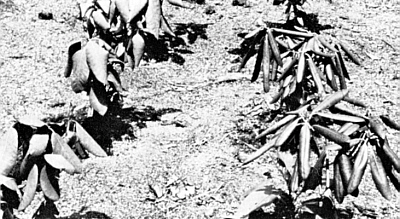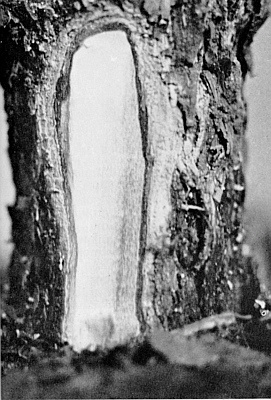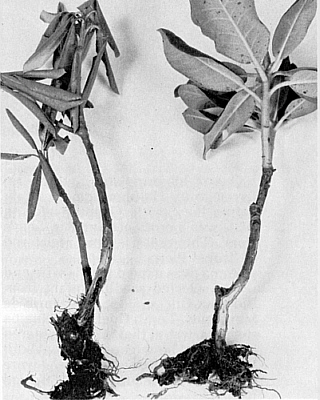QBARS - v29n4 Final Report on the 1974 Dieback and Wilt Disease Project
Report on the 1974 Rhododendron Dieback and
Wilt Disease Project
R. C. Lambe, Blacksburg, Virginia
Associate Professor of Plant Pathology, Department of Plant Pathology
and Physiology, Virginia Polytechnic Institute and State University,
Blacksburg, Virginia
The survey for disease of rhododendrons and azaleas conducted through the cooperation of members of the Middle Atlantic Chapter of the American Rhododendron Society and Virginia Polytechnic Institute and State University Extension Agents was very productive in terms of information on disease incidence and character of the pathogens involved. One hundred and fifty specimens were received in the Plant Disease Clinic. Of these 79 were rhododendron and 71 azalea.
The stated objectives of the projects were 1) to determine disease susceptibility of rhododendrons being grown and 2) to determine the kinds of pathogenic fungi associated with dieback and wilt. We were also interested in trying to determine the cultural and environmental factors contributing to disease. Definitive research on the most important diseases would be an outgrowth of this project.
The project began with a letter to the membership and VPI & SU Extension Agents requesting their assistance in the survey and suggesting that they use the new form, MR-139 prepared for the collecting, packaging and mailing of leaves, stems, roots and soil. The front page of the three page, no carbon required form, contained check off and fill in blanks for cultural practices, variety name and symptoms of disease as observed in the planting. The reverse side of the form contained the directions for collecting and packaging specimens. Members present at the annual spring meeting of the chapter were encouraged to cooperate. Previous to the initiation of the project, specimens received through various channels had been cultured, for root rots. A selective artificial media to recover water molds like species of Phytophthora and Pythium had been used with a high degree of success. This was developed by other researchers and contained 3 antibiotics antagonistic against most non-water mold root and soil inhabiting fungi. Where experience indicated that it would be desirable, roots were cultured on potato dextrose agar media for stem infecting fungi like Phomopsis and Botryosphaeria.
|
||||||
|
|
|||||
Results of the Survey
When soil accompanied the plant specimen or arrived alone with the MR-139 form, a sample was referred to the VPI & SU Soil Testing Laboratory for analysis. In addition to pH, minerals and organic content in certain instances where the description of disease or symptoms on the specimen seemed to indicate improper nutrition, a soluble salt test was requested. In other instance where symptoms suggested nematode damage a sample of soil was tested by the Plant Disease Clinic for parasitic nematodes.
If several plants, as in a commercial nursery, were involved in a particularly complex problem, leaf tissue was collected and together with a modest fee mailed to an out-of-state laboratory for mineral analysis. Leaf specimens were also received for disease analysis, usually fungus leaf spots.
A large number of the rhododendrons received were unlabeled as to cultivar or specie. Of the 19 that were labeled, most of these were of the large garden variety, but a few were the dwarf type. Whole plants, stems, root, and leaves were received for diagnosis. It became apparent early in the survey that dieback was frequently caused by Botryosphaeria, as this was the fungus isolated most frequently from diseased stems. Other fungi frequently recovered from dieback were Pestalotia and Phomopsis. At the end of the summer, we were successful in isolating Phytophthora citricola from stem tips. The roots of the plants sent in contained most frequently Phytophthora cinnamomi and Pythium spp.
The evergreen azaleas were most susceptible to disease, with the majority received being the white flower types like 'Delaware Valley White' and red flower ones like 'Honode Giri' and 'Hino Crimson'. Only two deciduous azaleas were received, one from a home planting and the other from a nursery.
Azalea roots and stems were cultured for disease-causing fungi using the two kinds of artificial media. Most of the wilting azaleas were
suffering from Phytophthora root rot, but Pythium and Pestalotia were frequently recovered. Dieback in azalea was common, but less so than in rhododendron and all plants contained either Phomopsis or Pestalotia. In several instances Rhizoctonia solani was cultured from the roots. Deciduous azaleas were infected by a Phytophthora sp.
Contributing to the death and decline of both rhododendrons and azaleas were the application of excess quantities of fertilizer as detected by a soluble salt analysis. Soil received with azaleas was often very heavy and probably impervious to the drainage of excess water. Improper planting and lack of cold weather protection were also apparent from the symptoms and information provided.
Growers either directly or through Extension Agents were provided with information on control where positive cause of disease could be ascertained. When a water mold fungus like Phytophthora was cultured, reference was made to the VPI & SU extension publication, CS-90,that contains information on the protection of healthy rhododendrons and azaleas adjacent to diseased ones. Diseases like Ovulinia petal blight CS-116 and leaf and flower gall, CS-119 are covered in detail and copies can be obtained through any extension office in Virginia. Because Botryosphaeria was causing symptoms that might be confused with those produced by Phytophthora spp., a special leaflet comparing the symptoms, cause and control was sent to all concerned.
The survey will be continued in 1975 through the cooperation of the Middle Atlantic Chapter of ARS using the same form. Members of the chapter and VPI & SU Extension Agents are asked to send in specimens together with the special form MR-139, a supply of which can be obtained from my office. Those sending in specimens requiring a delay in the laboratory will receive a card advising the sender. Because of the possibility that dieback disease may be a complex of more than one fungus, it is important to collect early in the spring and send in twig tips with limited discoloration of the growing tips. Examples of advanced dieback, where several inches or even feet are involved as detected with a sharp pocket knife, should be pruned out, but chemical sprays are ineffective if applied before dieback begins. If small plants are diseased, and can be packaged without much difficulty collecting the entire plant will be the most beneficial to the survey so that roots and soil can be tested.
Enclosure of a form MR-139 filled out as completely as possible will result in the greatest amount of information and hopefully lead to better disease preventative recommendations. Newsletters will be mailed to keep everyone up to date on the survey and the latest developments on cultural and chemical control of disease.



